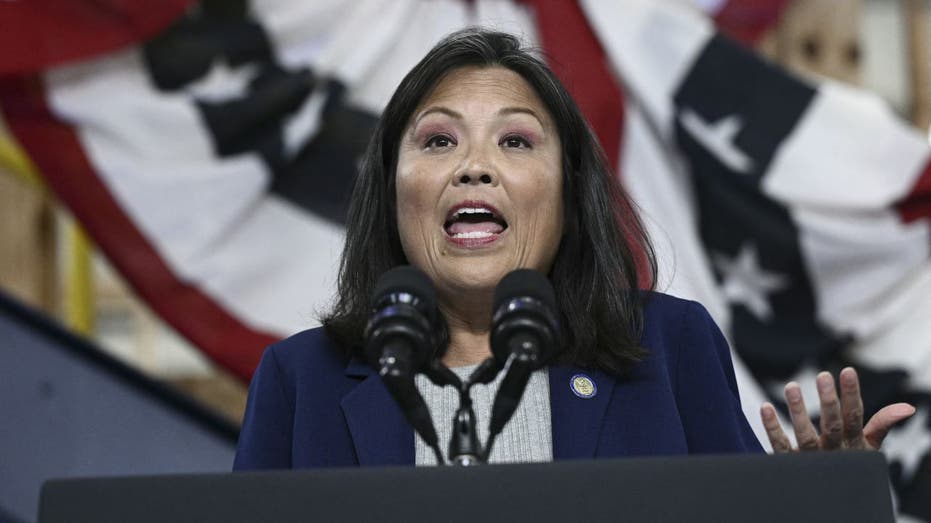Acting Labor Secretary Julie Su was asked about whether migrants who cross the border should be allowed to work in the U.S.
Federal Reserve Chair Jerome Powell said Wednesday that immigration is helping push the unemployment rate higher as they enter the labor force and look for jobs.
Powell was asked about whether the level of job creation in the economy, which has been a little more than 100,000 on average for the last three months, is alarming and if the labor market can continue slowing down through fewer job openings as opposed to job losses.
“On the job creation… it depends on the inflows,” Powell said. “So if you’re having millions of people come into the labor force, and you’re creating 100,000 jobs, you’re going to see unemployment go up. So it really depends on what’s the trend underlying the volatility of people coming into the country.”
“We understand there’s been quite an influx across the borders, and that has actually been one of the things that’s allowed the unemployment [rate] to rise. And the other thing is just the slower hiring rate, which is something we also watch carefully. So it does depend on what’s happening on the supply side,” he explained.
THE FED CUT RATES BY HALF-POINT: WHAT TO KNOW
Fed Chair Jerome Powell noted the rise in immigration can boost the unemployment rate as new workers enter the labor market. (Al Drago/Bloomberg via / Getty Images)
The unemployment rate has risen in recent months amid a slowdown in hiring. It reached 4% in May for the first time since January 2022 and hit 4.3% in July, before declining to 4.2% in August.
Powell’s comments come after the August jobs report showed a decline in employment among native-born workers while the number of employed foreign-born workers rose in the past year.
The Bureau of Labor Statistics (BLS) noted that in the past 12 months through August, native-born American workers lost over 1.3 million jobs, while foreign-born workers gained more than 1.2 million jobs in that span.
As of August, the BLS estimated there were 129,712,000 native-born workers – down from 131,031,000 in August 2023. By comparison, there were 31,636,000 foreign-born workers in August – an increase from 30,396,000 compared to a year ago.
JOBS REPORT IS A BOOM FOR MIGRANTS, SLUMP FOR AMERICANS

Illegal border crossings have surged in recent years under the Biden-Harris administration. (Lokman Vural Elibol/Anadolu via / Getty Images)
The BLS figures do not differentiate between foreign-born workers who entered the country with authorization, such as green card holders, and those with working visas, as opposed to those who entered the country without authorization.
Acting Labor Secretary Julie Su, who oversees the BLS, was asked by FOX Business Network’s Edward Lawrence, on Sept. 6 when the most recent jobs report was released, about whether migrants who cross the border without authorization should be allowed to work. Su declined to address that point but emphasized the importance of immigration to the U.S. economy.
“We see immigrant workers being really critical to important sectors in our economy from, you know, farmworkers, to construction and more,” Su added. “Everybody, every worker who does work should get a fair day’s pay for their hard day’s work and come home healthy and safe.”
FED DECISION OPENS THE REAL ESTATE FLOODGATES AFTER FOUR YEARS

Acting Secretary of Labor Julie Su downplayed knowledge of data showing the rise in foreign-born workers’ employment amid the decline in job-holding native-born workers. (Brendan Smialowski/AFP via / Getty Images)
When asked about the jobs report data showing the decline in native-born workers versus the rise in foreign-born workers, Su said she wasn’t aware of those figures.
“I’m not sure what you’re looking at. That’s not consistent with the data that we see and what we’re reporting. Again, we’ve had almost 16 million jobs created since the Biden-Harris administration came into office. The vast majority of those jobs have gone to native-born individuals. But immigrant workers have also been really, really key,” Su said.
Newsfromrss.com
Data from the Congressional Budget Office (CBO) found that there has been a net gain of more than 9 million immigrants since the end of 2020.
That figure includes 2.6 million lawful permanent residents who are green-card holders or otherwise came to the U.S. legally via family or employment-based visas, as well as 6.5 million who are classified as “other foreign nationals” – which comprises those who entered the country without authorization.
FOX Business’ Edward Lawrence and Michael Dorgan contributed to this report.


